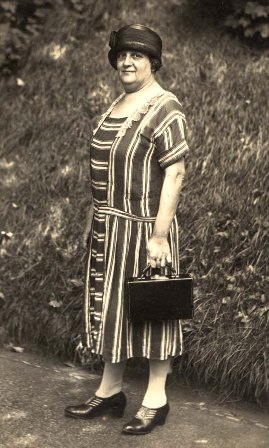Search for Names, Places and Biographies
Already layed Stumbling Stones
Suche
Lucia Bauer (née Ebenstein) * 1876
Breitenfelder Straße 4 (Hamburg-Nord, Hoheluft-Ost)
1941 Minsk
further stumbling stones in Breitenfelder Straße 4:
Ernst Bauer, Inge Bauer
Luzie Dorothea Bauer, née Ebenstein, born on 17 Apr. 1876 in Berlin, deported on 18 Nov. 1941 to Minsk
Breitenfelderstraße 4
Luzie Bauer was the daughter of Siegfried and Melanie Ebenstein, née Stern. Nothing is known about her childhood and youth, possible training, or the date of her marriage. Her husband Leopold, born on 21 June 1869, ran a business for tailor’s goods and sewing supplies. The two had three sons: Ernst, born in 1908 (see corresponding entry), Herbert, whose date of birth is unknown and who reached only eleven months of age, and Edgar, born on 29 Nov. 1913. When Edgar was nine years old, his father died of cancer on 8 Apr. 1923. Edgar developed a close bond to his mother. "He clung to her adoringly,” as an acquaintance would later say. For Luzie, difficult times were about to begin. As details reported by the family indicate, a female relative initially continued to manage the business, running it down to such an extent, however, that it had to be given up two years later. Luzie Bauer had no choice but to apply for welfare assistance. The two boys were placed under guardianship. The family lived at Elsässer Straße 50, then in the 1930s at Breitenfelderstraße 4. Luzie was a loving mother. When the children had done something naughty, she would wag her finger at them threateningly, saying "you, you, you.” In contrast to the educational methods common in those days, she apparently never hit her children.
Money was scarce. Edgar attended the Oberrealschule [a secondary school without Latin], where he was a good student. He reached the intermediate secondary school certificate at grade 10 with the help of a scholarship. As of 1930, he did a commercial apprenticeship with the Rudolf Mosse Company in the area of advertising dispatch, continuing work there upon completing his training. Since 1929/30, he was an active member in the "Black, Red, and Gold Banner of the Reich” ("Reichsbanner Schwarz Rot Gold”), the paramilitary association founded in 1924 by the Social Democrats to defend the Weimar Republic and its constitutional order. Probably because of a commentary about the Reichstag fire in 1933, Edgar was denounced, managing to elude his imminent arrest only by escaping. Apparently, he kept in hiding for a few days with acquaintances and then traveled to France once his guardian had procured the necessary identity papers. In Paris, he kept afloat by doing odd jobs and with assistance from the Jewish Aid Committee. When his two-year work permit expired, he fled onward to Brazil and reached Argentina via Uruguay in 1939.
Whether Luzie Bauer practiced an occupation is not known. The job description entered on the Jewish religious tax (Kultussteuer) file card of the Jewish Community reads "assistant clerk.” In Apr. 1938, she moved with her son Ernst to Heinrich-Barth-Straße 8, where the two lived together with Ludwig and Olga Pick as well as their daughter Inge. Inge Pick managed to depart for Britain in 1939, her parents were deported to Minsk. Luzie Bauer’s last address was the former Jewish residential home, now "Jews’ house” ("Judenhaus”), at Bundesstraße 35. It was there that the woman suffering from a heart condition received the deportation order to Minsk in Nov. 1941, soon after her son Ernst. Ernst had married Inge Neufeld in Apr. of that year. It is not known when the three were killed. Edgar Bauer, who had only a small income as an employee in South America, suffered his entire life from the effects of the flight he experienced and from the fact that he had been unable to save his mother and brother. He died in Buenos Aires in 1987. His daughter had the Stolpersteine laid in memory of Luzie, Ernst, and Inge Bauer.
Translator: Erwin Fink
Kindly supported by the Hermann Reemtsma Stiftung, Hamburg.
© Sabine Brunotte
Quellen: 1; 4; StaH 351-11 AfW Abl. 2008/1, 291113; mündliche Auskünfte Dr. Edith Theux, 3.8.2007 und 15.9.2010; dtv Lexikon Mannheim und München 1997, Bd. 15; Vieth, Hier lebten sie, 1993, S. 77.
Zur Nummerierung häufig genutzter Quellen siehe Recherche und Quellen.


